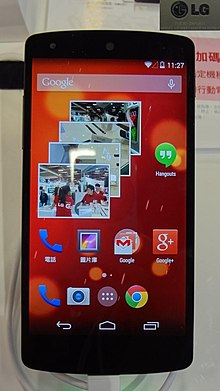Nexus 5
From Wikipedia, the free encyclopedia
 | |
 Front view of the Nexus 5 | |
| Codename | Hammerhead |
|---|---|
| Developer | Google, LG Electronics |
| Manufacturer | LG Electronics |
| Series | Google Nexus |
| Compatible networks | 2G/3G/4G LTE GSM: 850/900/1800/1900 MHz Model LG-D820 (North America) CDMA band class: 0/1/10 WCDMA bands: 1/2/4/5/6/8/19 LTE bands: 1/2/4/5/17/19/25/26/41 Model LG-D821 (international) WCDMA bands: 1/2/4/5/6/8 LTE bands: 1/3/5/7/8/20 |
| First released | October 31, 2013 |
| Availability by country | |
| Discontinued | 11 March 2015[1] |
| Predecessor | Nexus 4 |
| Successor | Nexus 6 and Nexus 5X |
| Related | LG G2 and Nexus 7 (2013) |
| Type | Smartphone |
| Form factor | Slate |
| Dimensions | 137.84 mm (5.427 in) H 69.17 mm (2.723 in) W 8.59 mm (0.338 in) D |
| Weight | 130 g (4.6 oz) |
| Operating system | Android "KitKat" 4.4, upgradable to Android "Marshmallow" 6.0.1 |
| System on chip | Qualcomm Snapdragon 800 |
| CPU | 2.26 GHz quad-core Krait 400 |
| GPU | Adreno 330, 450 MHz |
| Memory | 2 GB of LPDDR3-1600 RAM |
| Storage | 16 GB (12.55 GB available)[2] or 32 GB (26.7 GB available)[3] |
| Removable storage | Not available |
| Battery | 3.8 V 2300 mAh, 8 Wh Qi wireless charging |
| Data inputs | Multi-touch capacitivetouchscreen, Proximity sensor,Gyroscope, Compass, Barometer,Accelerometer, Hall effect sensor, Ambient Light sensor, GPS,[4]GLONASS, Beidou,[5] step counter and detector[6] |
| Display | 4.95 in (126 mm) Full HD1920×1080 px (445 ppi) IPS LCD, with Corning Gorilla Glass 3 |
| Rear camera | 8 MP Sony Exmor IMX179 1/3.2-inch CMOS sensor with OIS,[7]f/2.4 aperture[8] and LED flash. |
| Front camera | 1.3 MP |
| Sound | Monaural lateral loudspeaker,[7][9]dual microphones, 3.5 mm stereo audio jack |
| Connectivity | Micro USB, SlimPort, NFC,Bluetooth 4.0, 2×2MIMO[citation needed] Wi-Fi 802.11 a/b/g/n/ac (single stream) |
| Other | Multi-color LED notification light[10] |
| SAR | Head: 0.810 W/kg (1 g) Body: 0.998 W/kg (1 g) Hotspot: 0.998 W/kg (1 g)[11] |
Nexus 5 (codenamed Hammerhead)[12] is an Android smartphone manufactured by LG Electronics for Google. Co-developed with and marketed by Google Inc. as part of its Nexus line of flagship devices and unveiled on October 31, 2013, it is a successor to theNexus 4. Nexus 5 served as the launch device for Android 4.4 "KitKat", which introduced a refreshed interface, performance improvements, increased Google Now integration, better battery life and other features.
The Nexus 5 received mostly positive reviews, praising the device's balance of overall performance and cost in comparison to other "flagship" phones, along with the quality of its display and some of the changes introduced by Android 4.4. The display was, however, criticised for being too dim in comparison to other devices, and the camera was criticised for having inconsistent quality.
Contents
[hide]- 1Release
- 2Specifications
- 2.1Hardware
- 2.2Software
- 3Reception
- 4See also
- 5References
- 6External links
Release[edit]
The device was unveiled on October 31, 2013; it was made available for pre-order from Google Play Store the same day in 16 GB and 32 GB models.[13][14] When released, the Nexus 5 was priced at US$349 (16 GB version) and US$399 (32 GB version) in the US.[15][16] This was much lower than comparable smartphones, which would cost around $649.[17]
As of 11 March 2015, the Nexus 5 is no longer available from Google Play Store.[1]
Specifications[edit]
Hardware[edit]
The exterior of the Nexus 5 is made from a polycarbonate shell with similarities to the 2013 version of Nexus 7, unlike its predecessor that uses a glass-based construction. Three exterior colors are available: black, white and red.[18][19]
Its hardware contains similarities to the LG G2; it is powered by a 2.26 GHz quad-core Snapdragon 800 processor with 2 GB of RAM, either 16 or 32 GB of internal storage, and a 2300 mAh battery. The Nexus 5 uses a 4.95-inch (marketed as 5-inch) 445 PPI 1080p IPS display, and includes an 8-megapixel rear-facing camera with optical image stabilization (OIS), and a 1.3-megapixel front-facing camera. The Nexus 5 supports LTE networks where available, unlike the Nexus 4 which unofficially supported LTE on AWS Band 4 only with a hidden software option, but was not formally approved or marketed for any LTE use.[20][21] There are two variants of the Nexus 5, with varying support for cellular frequency bands; one is specific to North America (LG-D820), and the other is designed for the rest of the world (LG-D821).[20]
Notable new hardware features also include two new composite sensors: a step detector and a step counter. These new sensors allow applications to easily track steps when the user is walking, running, or climbing stairs. Both sensors are implemented in hardware for low power consumption.[6] Like its predecessors, the Nexus 5 does not have a microSD card slot,[22] while it features a multi-color LED notification light.[10] There are two grills present on the lower edge of the Nexus 5: one is for the mono speaker and the other is for the microphone.[7][9]
Software[edit]
Main article: Android (operating system)
The Nexus 5 was the first Android device to ship with Android 4.4 "KitKat", which had a refreshed interface, improved performance, improved NFC support (such as the ability to emulate a smart card), a new "HDR+" camera shooting mode, native printing functionality, a screen recording utility, and other new and improved functionality.
The device also shipped with Google Now Launcher, a redesigned home screen which allows users to quickly access Google Now on a dedicated page, and allows voice search to be activated on the home screen with a voice command. Unlike the stock home screen, Google Now Launcher is not a component of Android itself; it is implemented as part of theGoogle Search application. Until 26 February 2014, when it was released on Google Play Store for selected Android 4.4 devices, Google Now Launcher was exclusively shipped by default on the Nexus 5, and was not enabled in Android 4.4 updates for any other Nexus device. While an update to the Google Search application containing Google Now Launcher (which itself was tweaked to improve compatibility with other devices as well) was publicly released shortly after the Nexus 5's release, the launcher itself could not at the time be enabled without installing a second shim application.[23][24][25]
Hangouts, which now supports text messaging, is used as the default text messaging application.[6][26]
In December 2013, the Nexus 5 began receiving the Android 4.4.1 update, which fixed issues with auto focus, white balance, HDR+ and other camera issues,[27][28] while introducing some other camera issues for low-light scenes.[29] It also fixes low speaker volume output in certain applications.[30] Android 4.4.2 update followed in a few days, providing further bugfixes and security improvements.[31] In early June 2014, the Nexus 5 received Android 4.4.3 update that included dozens of bug fixes,[32] while another mid-June 2014 Android 4.4.4 update included a fix for an OpenSSL man-in-the-middle vulnerability.[33]
A developer preview of the Android 5.0 "Lollipop" system image was released for the Nexus 5 after the annual Google I/Oconference held on June 26, 2014.[34] The release version of Android 5.0 "Lollipop" was made available on November 12, 2014, in form of factory operating system images.[35] On December 15, 2014 Android 5.0.1 "Lollipop" update began rolling out to Nexus 5 with build number LRX22C, the update was listed as being “miscellaneous Android updates.”[36] In March 2015, the Nexus 5 began receiving the Android 5.1 "Lollipop" update, which addresses performance issues and other user interface tweaks;[37] however, it is known to introduce certain camera issues.[38][39] In June 2015, Google made the Android 5.1.1 "Lollipop" update available for Nexus 5 aiming to fix the bugs that were not fixed by Android 5.1 update.[40]
In May 2015, a developer preview of Android Marshmallow was made available for the Nexus 5.[41]
In November 2015, Nexus 5 started receiving Android 6.0 "Marshmallow" update across the world.[42] Following which Nexus 5 became one of the first devices to get an Android 6.0.1 Marshmallow update in December 2015.[43]
Besides official Android releases, third-party builds are also available, including CyanogenMod, MIUI, AOKP, Paranoid Droid,OmniRom, NetHunter, KDE's Plasma Mobile,[44] Sailfish OS[45] and FirefoxOS.[46]
Reception[edit]
The Nexus 5 received mostly positive reviews; critics felt that the device provided a notable balance between performance and pricing.[47][48] Although noting nuances with its display, such as its color reproduction and low maximum brightness in comparison to competitors, CNET praised software features such as the new phone dialer interface and Google Now integration on the home screen, but did not believe KitKat provided many major changes over its predecessors. Hangouts as the default text messaging app was criticised for its user interface and for attempting to force the use of a Google service, while the quality of photos taken with the device was described as being "great, but it didn't particularly blow me away." In conclusion, the Nexus 5 was given a 4 out of 5, concluding that "to even compare this $400 phone to those that cost upward of $650 unlocked (like the Samsung Galaxy S4, HTC One, and Apple iPhone 5S) speaks volumes about the Nexus 5's massive appeal and affordability", and that the device "extends the allure of the Nexus brand to anyone simply looking for an excellent yet inexpensive handset."[48]
Engadget was similarly positive, but noted that the device's LTE support was lacking, as its supported bands are segregated across two model variants, and does not supportVerizon Wireless. While praised for its crisp quality, it was noted that the display did not render colors (particularly black and white) as richly as the Galaxy S4, but added that "if you think saturated colors are overrated anyway, you're going to love the display here." While considered an improvement over the Nexus 4, the device's battery life was criticised for not being as good as its competitors, and the quality of its camera was considered to be inconsistent. In conclusion, Engadget argued that "whether or not it was the company's intent, Google is sending a message to smartphone makers that it's possible to make high-quality handsets without costing consumers the proverbial arm and leg. Now we just wait and see if that message will be warmly received."


0 Response to "Nexus 5"
Post a Comment